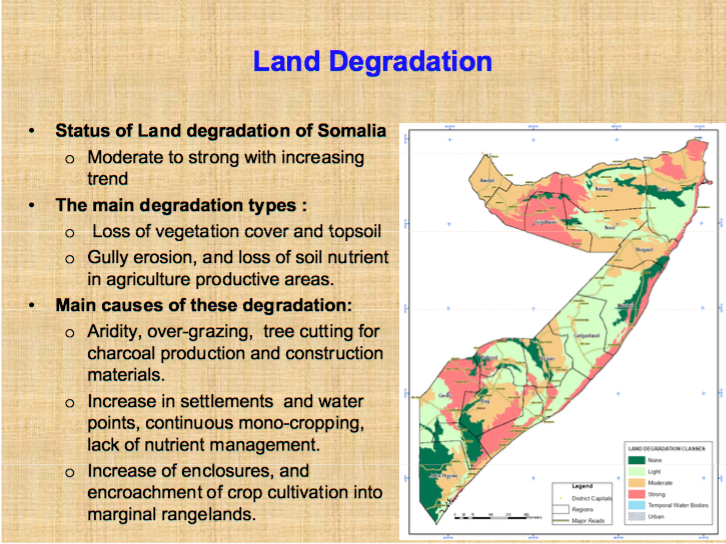The Horn of Africa is becoming drier in step with global warming, researchers said on Friday, contradicting some climate models predicting rainier weather patterns in a region that has suffered frequent food crises linked to drought.
A new study using a sediment core extracted from the Gulf of Aden found the East African region covering Somalia, Djibouti and Ethiopia has dried at an unusually fast rate over the past century.
Lead author Jessica Tierney, an associate professor at the University of Arizona, told the Thomson Reuters Foundation the research team was confident the drying was linked to rising emissions of climate-changing greenhouse gases, and was expected to continue as the region heats up further.
"If the region becomes dry, like we think it might get, that completely changes your models for food security and agriculture," she said.
Study co-author Peter deMenocal of Columbia University's Lamont-Doherty Earth Observatory warned that many aid groups are expecting "a wetter, greener future for the Horn of Africa". But the new findings show "the exact opposite is occurring".
The study could have important implications for a region that has suffered political instability and violence alongside regular droughts and hunger in recent decades, forcing people from their homes and fuelling piracy on the seas off Somalia.
The scientists used isotopes from leaf waxes found in the 1-metre sediment sample from the ocean bed - extracted while dodging Somali pirates in 2001 - to compare rates of drying over the past 2,000 years.
When the climate is drier, leaf waxes are more enriched with heavy hydrogen isotopes. The scientists detected an increasing shift towards heavy hydrogen in the last century as the climate dried out after a wet period during the Little Ice Age from 1450-1850.
"What we see in the paleoclimate record from the last 2,000 years is evidence that the Horn of Africa is drier when there are warm conditions on Earth, and wetter when it is colder," Tierney said.
Global-scale models used to predict future changes have suggested the region would become wetter due to higher rainfall in the "short rains" season from September to November.
But the new study, published in Science Advances, said those gains may be offset by declining rainfall during the "long rains" season from March to May, on which local rain-fed agriculture relies.
Tierney said the findings would increase uncertainty around climate predictions now, but should help build a more accurate picture in the longer run.
More work is needed to develop finer-resolution regional models that can more accurately predict precipitation shifts in both rainy seasons, as well as to clarify the link between greenhouse gas emissions and drying, she said.
mobile.reuters.com/article/idUSKCN0S328K20151009
A new study using a sediment core extracted from the Gulf of Aden found the East African region covering Somalia, Djibouti and Ethiopia has dried at an unusually fast rate over the past century.
Lead author Jessica Tierney, an associate professor at the University of Arizona, told the Thomson Reuters Foundation the research team was confident the drying was linked to rising emissions of climate-changing greenhouse gases, and was expected to continue as the region heats up further.
"If the region becomes dry, like we think it might get, that completely changes your models for food security and agriculture," she said.
Study co-author Peter deMenocal of Columbia University's Lamont-Doherty Earth Observatory warned that many aid groups are expecting "a wetter, greener future for the Horn of Africa". But the new findings show "the exact opposite is occurring".
The study could have important implications for a region that has suffered political instability and violence alongside regular droughts and hunger in recent decades, forcing people from their homes and fuelling piracy on the seas off Somalia.
The scientists used isotopes from leaf waxes found in the 1-metre sediment sample from the ocean bed - extracted while dodging Somali pirates in 2001 - to compare rates of drying over the past 2,000 years.
When the climate is drier, leaf waxes are more enriched with heavy hydrogen isotopes. The scientists detected an increasing shift towards heavy hydrogen in the last century as the climate dried out after a wet period during the Little Ice Age from 1450-1850.
"What we see in the paleoclimate record from the last 2,000 years is evidence that the Horn of Africa is drier when there are warm conditions on Earth, and wetter when it is colder," Tierney said.
Global-scale models used to predict future changes have suggested the region would become wetter due to higher rainfall in the "short rains" season from September to November.
But the new study, published in Science Advances, said those gains may be offset by declining rainfall during the "long rains" season from March to May, on which local rain-fed agriculture relies.
Tierney said the findings would increase uncertainty around climate predictions now, but should help build a more accurate picture in the longer run.
More work is needed to develop finer-resolution regional models that can more accurately predict precipitation shifts in both rainy seasons, as well as to clarify the link between greenhouse gas emissions and drying, she said.
mobile.reuters.com/article/idUSKCN0S328K20151009






 We have land there and I didn't know about these changes.
We have land there and I didn't know about these changes.





